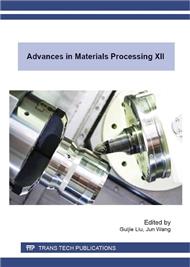p.3
p.9
p.14
p.20
p.26
p.32
p.38
p.44
p.50
A Study on Grinding Brittle Material with Pattern-Dressed Wheel
Abstract:
The high hardness of brittle materials always make it hard to machine with traditional grinding wheels. Conventionally a diamond grinding wheels was used to improve the poor processing capability. Usually the specific grinding energy had been used as an indicator of machinability. According to its definition, the specific grinding energy increases with the active contact area of the grinding wheel decreases. In other words, reducing the surface contact area of the grinding wheel can enhance the specific grinding energy effectively. Conditioning grooves on grinding wheels not only enhance the specific grinding energy, but also achieve the effect of reducing the heat dissipated during the grinding processes. With the proper selection parameters, the high cost of diamond grinding wheel may be replaced by less expensive conventional green carbon and aluminum oxide wheel. In this studies, the relationship between the surface topography of grinding wheels and the grinding capability of brittle materials was investigated. The results show that, the traditional grinding wheel dressing properly while the depth of cut less than 20μm with the rhombic pattern and the depth of cut more than 20μm with the groove-like pattern can grind the brittle materials as good as using diamond wheel.
Info:
Periodical:
Pages:
14-19
Citation:
Online since:
July 2016
Authors:
Keywords:
Price:
Сopyright:
© 2016 Trans Tech Publications Ltd. All Rights Reserved
Share:
Citation:


